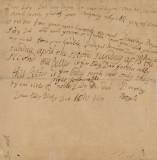This important drawing was made by William Kent and shows his designs for the overdoor figures sculpted by Michael Rysbrack for both the East façade and entrance to the Stone Hall at Houghton Hall in Norfolk. Houghton was constructed to the designs of James Gibbs and Colin Campbell for the Whig magnate, Sir Robert Walpole, the structure seems to have been largely completed by 1722. Kent’s involvement dates to around 1725 when he began work on the interiors of the house. Kent, fresh from redecorating a number of fashionable interiors, including Wanstead House and Kensington Palace, was emerging as the preeminent designer of the period. Kent relied on a roster of talented artists to assist in the execution of his projects and at this date, the sculptural elements were produced by the Flemish sculptor Michael Rysbrack.
Initially trained as a painter, Kent spent a decade working in Italy where he met an important roster of Grand Tourists. Established in London from 1720 Kent became the key artistic figure in a sophisticated circle of patrons interested in reforming the arts in Britain, chief amongst them Richard Boyle, 3rd Earl of Burlington. Kent worked on Burlington’s London house and became a key figure in the design and ornamentation of Chiswick House, Burlington’s neo-Palladian villa. It was for Burlington at Chiswick that Kent designed two statues of Andrea Palladio and Inigo Jones, sculptures that were modelled and executed in Portland Stone by Michael Rysbrack. The relationship between artist and sculptor was unusually close and collaborative. The engraver and antiquarian George Vertue was critical of the credit Kent took for some of their collaborations, writing about the tomb for Sir Isaac Newton, designed by Kent and executed by Rysbrack, Vertue tartly noted:
‘a noble and Elegant work of Mr Michael Rysbrack. Much to his Reputation. Tho the design or drawing of it on paper was poor enough, yet for that only Mr Kent is honourd with his name on it… which if it had been delivered to any other Sculptor besides Rysbrack, he might have been glad to have his name omitted.'[1]
Vertue’s objection aside, the present drawing shows how the figures were entirely of Kent’s conception, the sheet also shows that the two sets of figures (external and internal) were conceived simultaneously. On the façade, Kent designed two reclining figures depicting Minerva and Neptune and internally figures of Peace and Plenty. The figures were initially modelled in terracotta by Rysbrack, who kept them in his studio until the auction of his collection in 1764.[2] The reclining figures of Peace and Plenty were politically potent symbols at the heart of Kent’s scheme for Walpole, representing the ideal foreign and domestic policies of Britain’s first Prime Minister. Kent conceived the personifications of Peace and Plenty as languid women, introducing an unusual feminine note to the decidedly masculine Stone Hall, with its busts of Roman emperors, Walpole himself and Rysbrack’s overmantel relief of an ancient sacrifice.
The drawing appears to have been retained by Kent, at some point the verso was inscribed by Lady Dorothy Boyle, the eldest child of his friends and patrons the Earl and Countess of Burlington. The childish script records several drafts of a letter to a friend.





